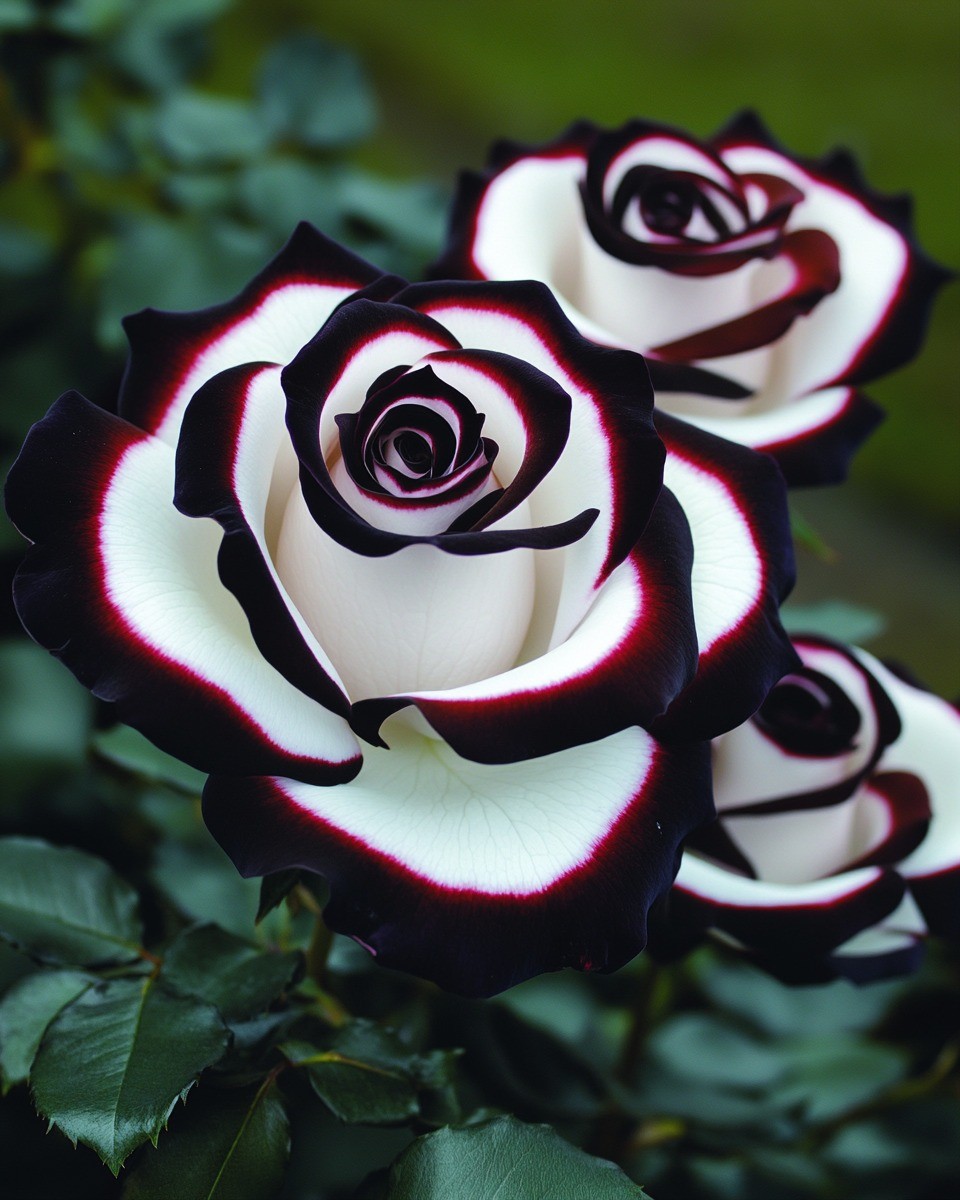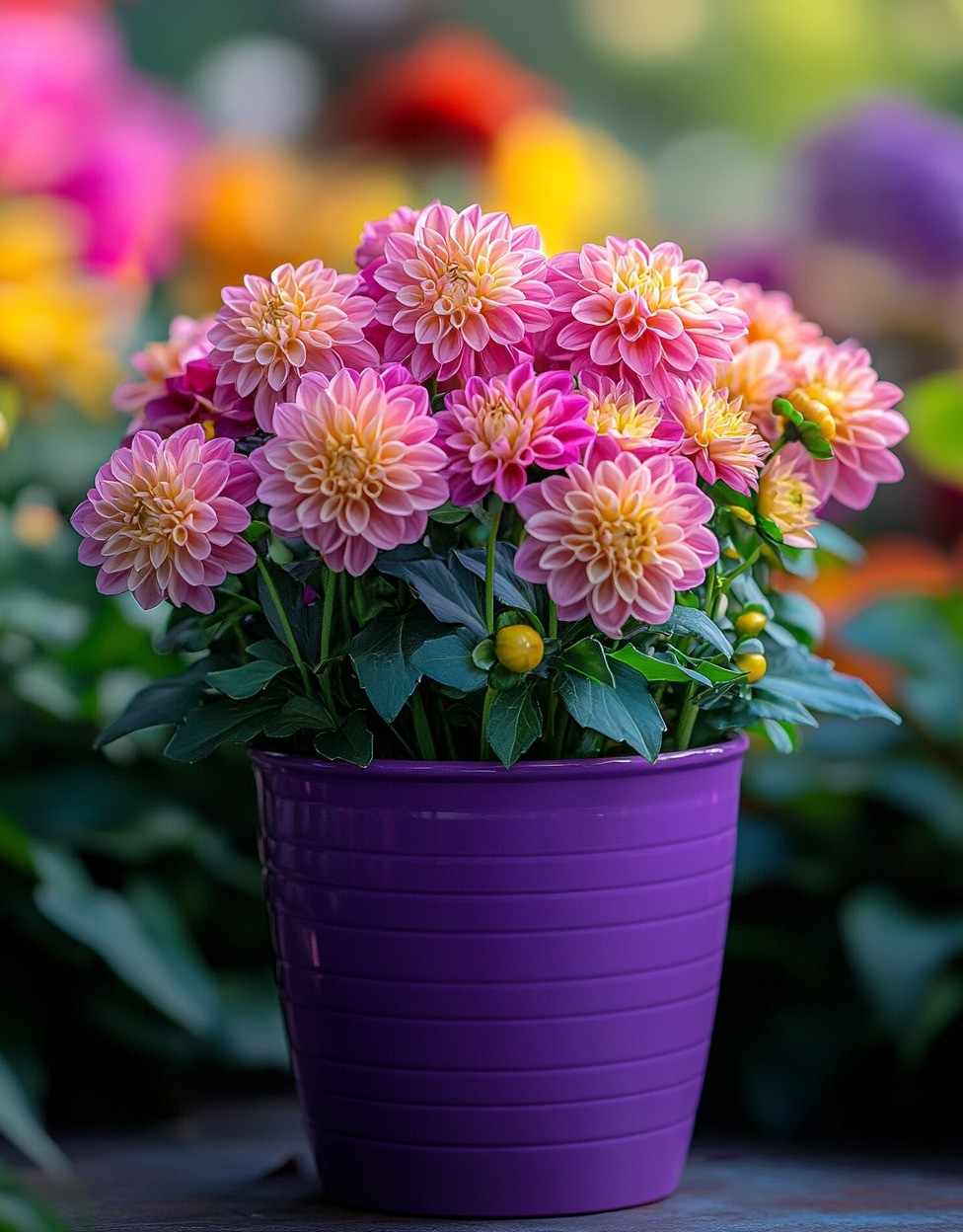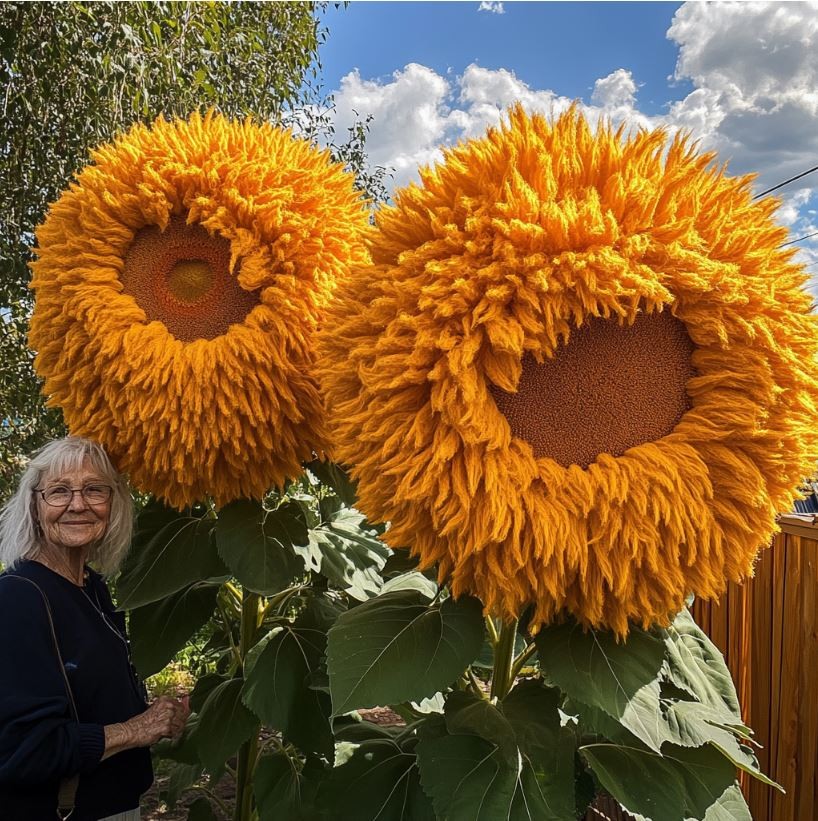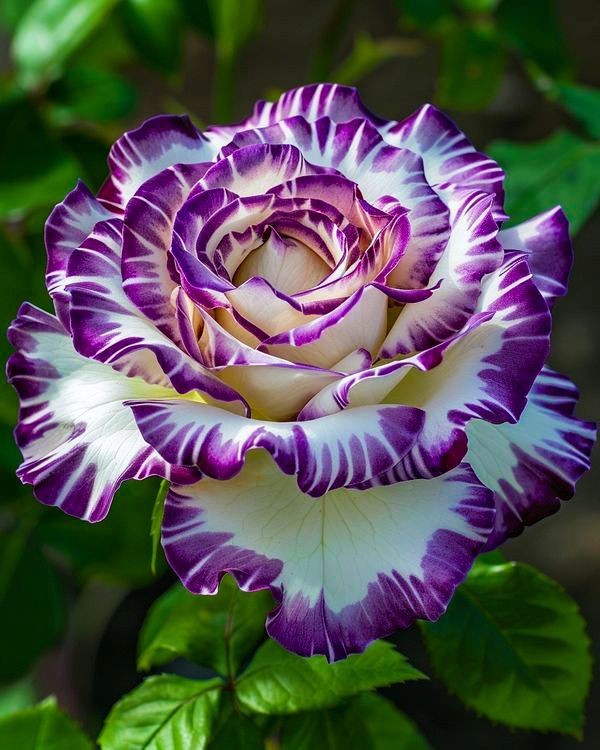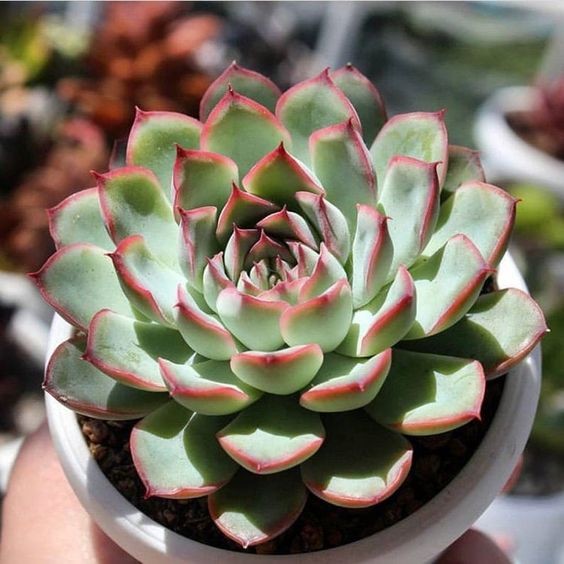Are you looking for dramatic contrast and unusual colors for your garden? Then black and white flowers must be top of your list! Think day and night, snow and pitch, combined together in decorative patterns on striking blooms…
Imagine them blossom on the green foliage of your borders, or standing out between perennials and annuals in your flower bed. Or you could even have them in containers on your terrace, for an original and unforgettable effect!
But is all this really possible? Yes, but to a certain extent! White blossoms are quite common, but how about black ones? And bicolor… To be fully honest, there is no real black in flowers, but very, sometimes even “very, very” dark shades of purple.
However, the effect is the same, and, especially from a distance, it will look like you have achieved the impossible in your garden!
It is really hard to find plants with black and white blooms, so, we took some time and collected the most credible list of all, and here it is!
This checkered list will wow you with its amazing black and white flowers, but first, we need to be honest with you…
Do Black and White Flowers Really Exist?
…And this is the big question…
White flowers do, at least for us humans…
Because bees see them in many mote colors, but how about blooms that are really black?
Well, we need to be honest and I am sorry I have to disappoint you.
There is not a single black flower in the whole world, not even with a tiny bit of black!
The reason for this is very simple indeed: there are no black pigments. However, some purple tonalities can become so dark, that they appear as almost black.
And this color is more convincing if there is some deep blue in the combination as well, so, varieties that don’t have blue in their range may give you a less credible effect.
And we will tell you in the descriptions if there are any issues with coloration. Honestly.
Finally, it may happen that where the two colors meet, you will get a transition zone, where the actual purple that forms the base becomes evident, even with bright, mauve hues.
But now, without further ado, let’s see the results of our research, and meet the most convincing, most credible plant varieties with black and white flowers!
18 Plants with Convincing White And Black Flowers
Looking around, you will see that many of the flowers in black and white, really fail on the first color… But, after a long search, we have found 18 varieties that are quite convincing, and here they are!
1: ‘Black Eyed Angels’ Candle Larkspur (Delphinium x elatum ‘Black Eyed Angels’)
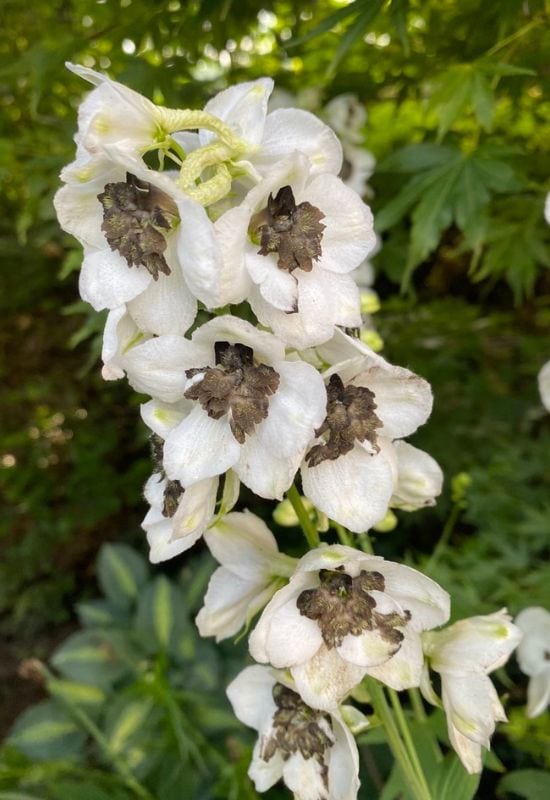
One of the most convincing varieties of black and white flowers is a Delphinium hybrid, a candle larkspur suggestively called ‘Black Eyed Angels’. And you will understand why when you look at it…
The frilly and broad petals that open on the tall spikes are as candid and bright as snow, in an orderly but dense cluster.
But you won’t fail to spot the dark, night colored central bees, and, in the double cultivar, these transform into small petals of super deep purple and – again – white.
This striking match of opposite tonalities will last for months, starting in early summer and keeping your garden unique into the first weeks of fall.
This is a member of the ‘New Millennium’ series, famous for its strong stems, and tolerance of both hot and humid conditions.
The upright will tower above a finely textured mound of deep green, finely cut leaves that complete the show.
Ideal for a herbaceous border of flower bed, ‘Black Eyed Angels’ candle larkspur is easy ti grow and suitable for traditional looking landscapes, like an English country or cottage garden. But given the exceptional strength of the stems, it can also be an unusual cut flower in black and white.
2: ‘Black and White Minstrels’ Pink (Dianthus chinensis heddewigii ‘Black and White Minstrels’)
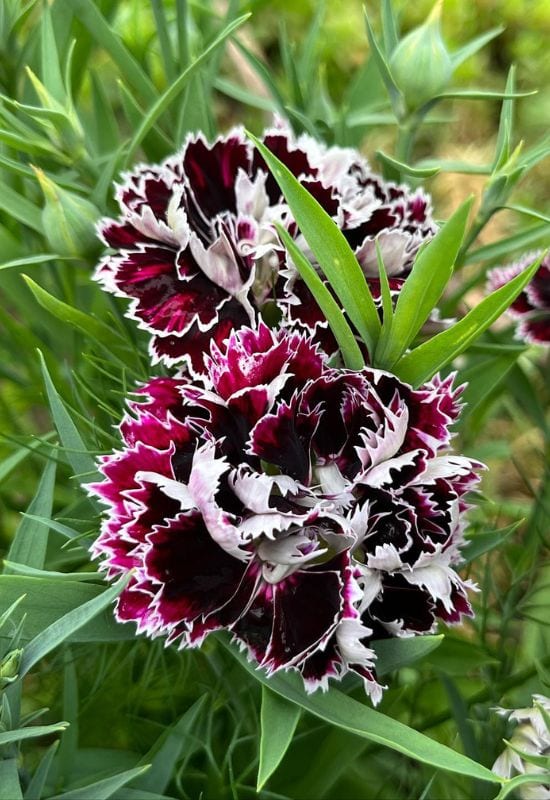
The amazing impact of ‘Black and White Minstrels’ pink is hard to match! Not only do its summer flowers have a very deep, intense and dark shade of purple that we gardeners usually call “black”, in fact… This will be on the upper leaf of the dented, frilly looking petals, taking up most of them.
At the margins, however, you have a very contrasting white, which perfectly defines the intricate shapes of the fully double flowers. In the “twilight zone” between them, the two colors mix for a brief moment, flaming up to a brilliant magenta…
Each blossom is about 1 inch across (2.5 cm), and you can expect lots all through the hot season and sometimes into fall, as long as you deadhead the spent blooms and you don’t let it seed. Yet another twist to this amazing Dianthus variety is that the tuft of dense, healthy looking long and pointed leaves has a wonderful greenish blue tonality!
Both cold hardy and heat tolerant ‘Black and White Minstrels’ pink is a perfect eye catching variety in flower beds and border fronts, for edging and in rock gardens, or in s small posy as a cut flower. And this is thanks to its light and darkness effect.
3: ‘Susie White’ Black Eyed Susan Vine (Thunbergia alata ‘Susie White’)
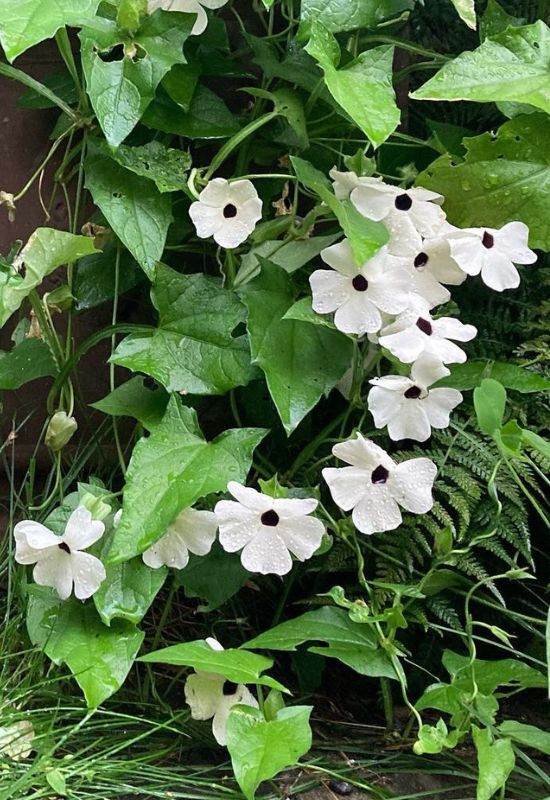
Black eyed Susan vine is not the popular daisy like Rudbeckia hirta, but an exotic looking climber with an extremely dark, really black looking, round blotch at the center… However, while most varieties have warm colors (pale orange, pink and red) around it, one particular cultivar, called ‘Susie White’ has candid snow white instead!
This makes it very spectacular and unusual indeed, also because the many flowers are about 2 inches across (5.0 cm), with five broad, almost heart shaped petals! What is more, this floral display will last for months and months on end…
In fact, you will see the first blossoms in June and the last ones in September (if you live in the Northern Hemisphere, of course). The slender vines also bear a sea of glossy and rich green, roughly heart shaped leaves that form a wonderful florid wall to frame its blossoms.
‘Susie White’ black eyed Susan vine is a great choice for a night and day effect on a green backdrop to drape arbors, trellises, fences, to fall over walls or down hanging baskets. While it is very exotic and tender, it will suit tropical looking gardens, Mediterranean ones but also more traditional ones, like a cottage or English country landscape.
4: ‘Snowstorm’ Baby Blue Eyes (Nemophila menziesii var. atomaria ‘Snowstorm’)

Also called California blue bells, baby blue eyes is the famous annual that blossoms like a calm sea in the spectacular Hitachi Seaside Park in Japan – you must have seen the pictures!
But there is one variety, ‘Snowstorm’ that does not have the color of the sky… ‘Snowstorm’ instead will give you a white blanket like snow in winter, but on its petals, you will also see lines of dots in such a dark shade of violet purple that it looks black! Some flowers have more of these, some a few less, but they all display them.
Each blossom is about 1.5 inches across (4.0 cm), bowl shaped and upward facing, and this heavenly plant has a very unusual season.
In fact, it will bloom from late winter to early summer, being one of the earliest flowering annual wildflowers.
Known for the profusion of its displays, it will also offer you a lovely tuft of basal leaves in rich green hues and fine texture, because the foliage is very deeply lobed.
You could grow ‘Snowstorm’ baby blue eyes for ground cover, or in a wild meadow, and have a massive white effect with black dots. But you can equally have it in flower beds, for edging and in containers.
Its small size makes it perfect for rock gardens as well, and it definitely suits a natural looking and informal style. It does not like hot summers and humid weather.
5: ‘Stealth’ Slipper Orchid (Paphilopedilum ‘Stealth’)
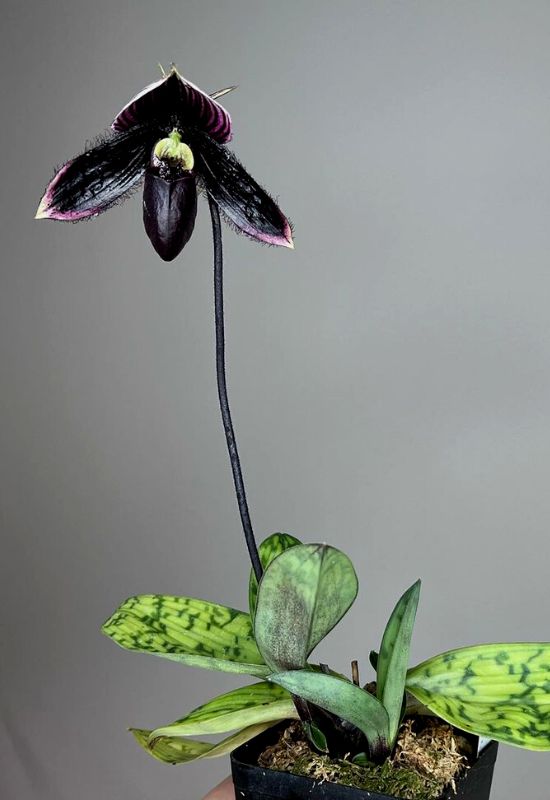
Did you know that orchids have the largest color range of any flower? And in fact, you can even find convincingly black ones, like ‘Stealth’ slipper orchid. It is a recent hybrid by Krull-Smith from Orchid Zone between Paphilopedilum ‘Hsinying Maru’ and Paphilopedilum rhothschidlianum, introduced in 2007.
With its long and pouch shaped labellum (the “lip”), two arching side tepals and a broad and pointed upper one, it is striking sight indeed! And its shade is such a dark tonality of purple, that we can confidently call it “black”.
Sometimes almost the whole bloom is painted like night, but more often, stripes of white emerge at the tips, sometimes fading to brighter wine purplish in between.
Each blossom is about 6 inches across (15 cm) and literally jaw dropping. The elegant, fleshy and glossy arching leaves at the base add a final touch to this otherworldly floral display.
Unfortunately, ‘Stealth’ slipper orchid is very hard to find and impressively expensive! Expect to pay in excess of $500 for a single plant. For this reason, the only suitable place for it is a greenhouse or a perfect home with steady temperatures, light and conditions.
6: ‘New York Night’ and ‘Midnight Ruffles’ Hellebores (Helleborus ‘New York Night’ and Helleborus ‘Midnight Ruffles’)
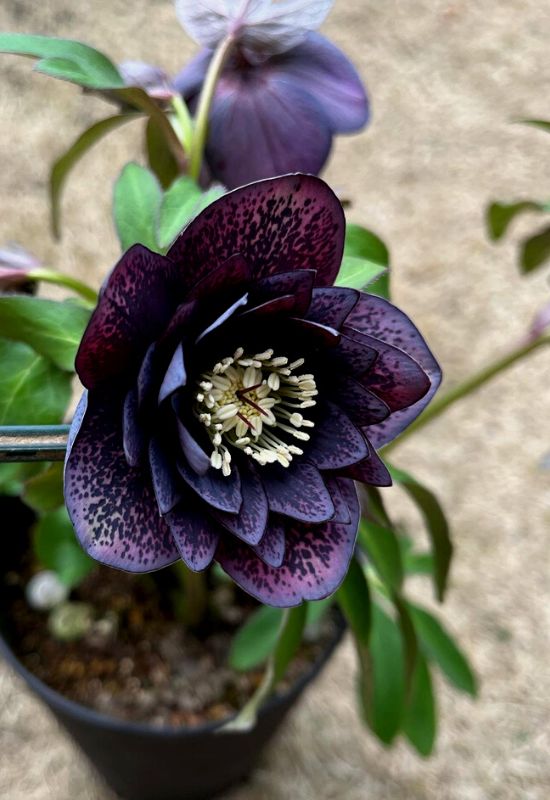
From a very demanding and rare orchid, to two Helleborus cultivars that will cost you little and ask for low maintenance: hellebore ‘New York Night’ from the Honeymoon Series and hellebore ‘Midnight Ruffles’ from the Winter Thrillers Series…
Both have very, very dark and deep purple petals, almost black, and both have a tuft of cream white pistils in the middle that gives you great contrast!
These will stretch out from a pale butter shaded center. In fact, they must be some of the darkest hellebore varieties ever, and this is yet another genus with an impressive color range…
The blossoms will appear in early spring and continue for almost two months, looking outward and reaching about 3 inches across (7.5 cm). So, what’s the difference?
‘New York Night’ is a single variety, while ‘Midnight Ruffles’ has double blooms… Take your pick! The deeply lobed, lush, and fresh looking foliage forms a very attractive clump at the base, which will last through the year, as both are evergreen!
Cold hardy and easy to grow, both ‘New York Night’ and ‘Midnight Ruffles’ hellebores are very striking additions to flower bed, rock gardens, containers or shady border fronts.
However, despite their unusual look, they will also naturalize easily for areas of your garden which you want to go wild!
7: ‘Dalmatian White’ Common Foxglove (Digitalis purpurea ‘Dalmatian White’)
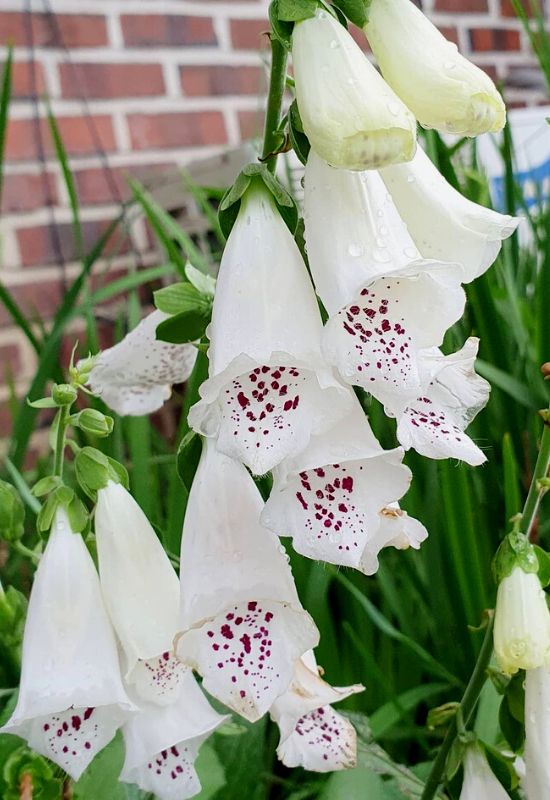
There are a few varieties of common foxglove with dark purple and white, but I find winner of the prestigious Award of Garden Merit by the Royal Horticultural Society ‘Dalmatian White’ the most convincing. And this is not just because the name refers to the famous black and white dogs…
For example, a contender is ‘Pam’s Split’, but the dark blotches in the throat of the blossoms are a bit to big for a trompe l’oeil… You will definitely see that the “black” is dark purple. On the other hand, ‘Dalmatian White’ has small spots, and the overall effect is more convincing.
The blossoms will open on packed upright spikes, facing out and down, and starting from the bottom in early summer. This short lived perennial will blossom in its first year, above the rosette of oblong and downy green leaves. Its floral display will be enhanced by lots of colorful butterflies, pollinators and even humming birds who will come to visit it and feast in its nectar.
‘Dalmatian White’ common foxglove looks better if group planted, especially in borders, beds or naturalized areas. It will definitely suit traditional and informal landscaping styles, and it is a must have if you want the black and white effect in a cottage garden.
8: ‘Carmel White’ Poppy Anemone (Anemone coronaria ‘Carmel White’)
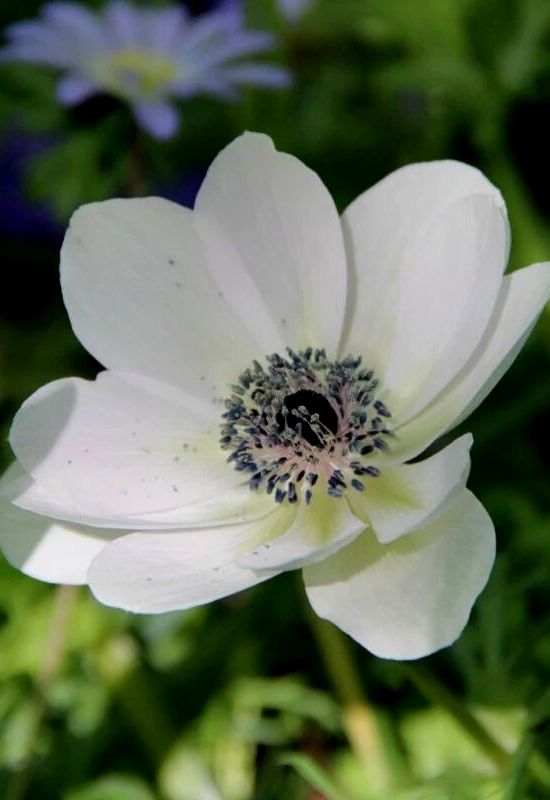
A striking variety from the De Caen group, poppy anemone ‘Carmel White’ is one of the most convincing flowers in black and white. Just have a look at it and you will find it hard to see that the central eye, with its shiny and almost metallic dusting is indeed a very, very deep blue purple.
The beautiful ring of pistils too is in the exact same tonality, and this gives you a bolder effect, against the snow colored broad petals of this semi double variety. It will blossom profusely from mid to late spring, attracting pollinators like butterflies and bees to your garden.
Add the deeply cut leaves of this bulbous perennial, and you will see why it forms natural bouquets with this amazing color combination. While it is not cold hardy, you can winterize the corms and have them in a temperate garden. But do remember to soak them for a few hours before planting them.
Poppy anemone ‘Carmel White’ from the De Caen series has that “old world” look you want in traditional and natural looking gardens, where you can grow it in flower beds or border fronts, containers or rock gardens. But remember that it is also an excellent cut flower – and in white and black, there are very few!
9: ‘Black Spider’ Asiatic Lily (Lilium auratum ‘Black Spider’)
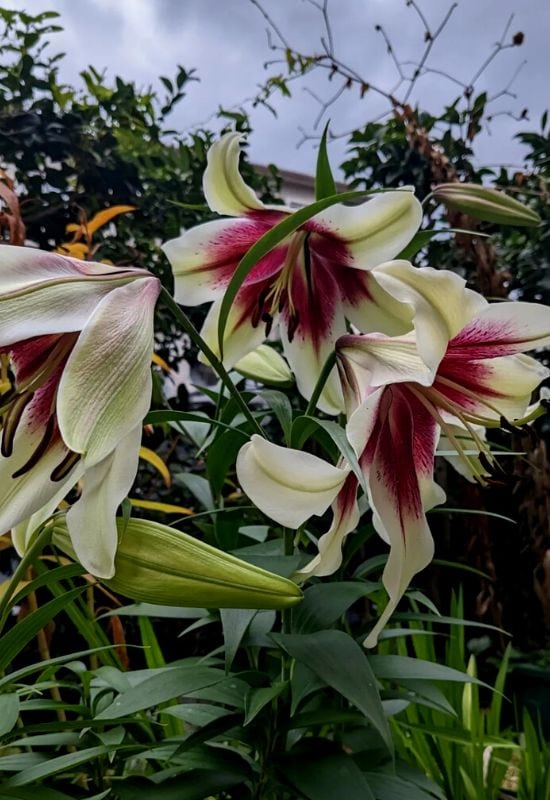
If you are looking for a super showy variety with in the shades of night and day, of pitch and snow, you want to have a look at ‘Black Spider’ Asiatic lily!
This bulbous perennial will give you massive blooms with the iconic six petals, up to 8 inches across, in a group of 4 to 8 at the top of a straight and upright stem, up to 8 inches across each (20 cm)!
The large and fragrant flowers have an ivory hue which darkens to deep purple and then almost black towards the center, with droplets in the transition zone, as if someone has splashed paint onto the blossoms!
Of course, like with other “proper” lilies (Lilium spp.) the long stamen and in particular extended pistils are a beauty to behold too…
The large and saffron orange pistils are quite eye catching – but remember that they stain clothes (and noses when you get close to smell it)… Pointed and rich emerald green laves lead you down towards the base, where this hybrid hides its bulb…
A hardy variety, ‘Black and White’ Asiatic lily is a great choice if you want to enjoy a bold black and white effect in borders, flower beds or containers, but also if you want it indoors, as it is an outstanding fresh cut flower!
10: ‘Penny Black’ Baby Blue Eyes (Nemophila menziesii ‘Penny Black’)
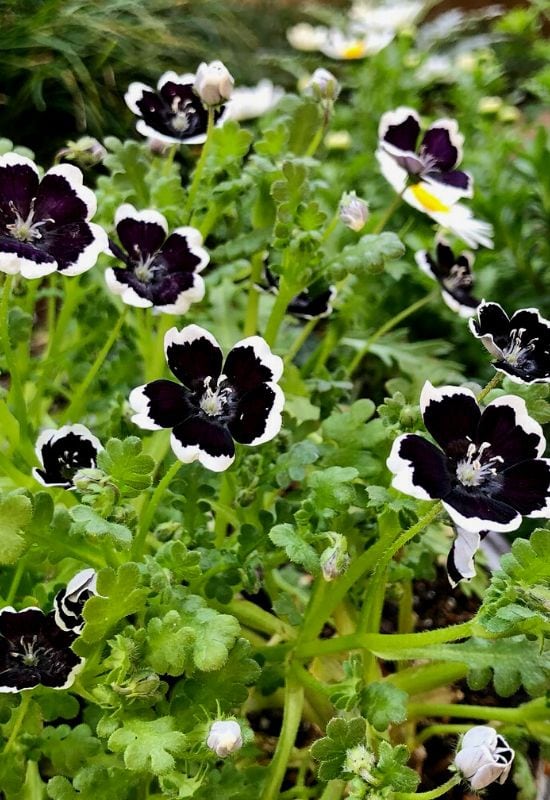
Here is another variety of baby blue eyes with our rare color combination, but with a much bolder effect than ‘Snowstorm’: ‘Penny Black’! In fact, the round and bowl shaped blooms are almost all of the color of night!
The dark patch at the center almost extends to the very edges of the broad petals, but then, just as you get to the edges, you will see a white stripe that draws the contour of the blossoms!
It’s like the negative of an old fashioned photograph, if you remember them… Each upward facing flower is about 1.5 inches across (4.0 cm), in itself very showy (also due to the amazing contrast); however, the main effect comes from the numbers that this annual wildflower can produce!
Literally hordes of them will come again and again and all the way from late winter to early summer! All this will happen on a carpet of finely textured and deeply lobed green leaves…
‘Penny Black’ baby blue eyes needs group or mass planting to achieve the best results! Its black and white flowers will work wonders in wild prairies and naturalized areas, but, being quite showy they fan also add a decorative contrast in flower beds or for edging.
11: ‘Sappho’ Rhododendron (Rhododendron ‘Sappho’)
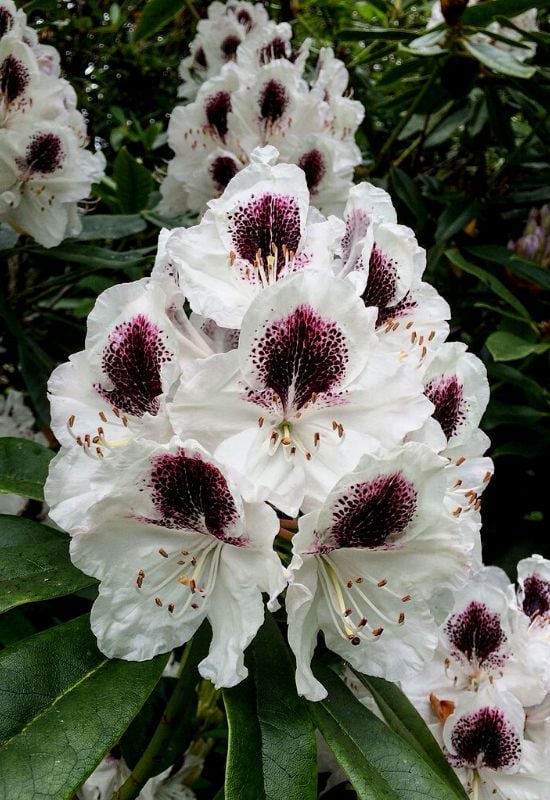
For a shade loving shrub with amazing floral displays in black and white, there’s a wonderful rhododendron hybrid, called ‘Sappho’, after the oldest poetess of the Western World (or the Greek island…).
This summer bloomer will produce masses of large, funnel shaped flowers where the color of snow meets a dark purple black plume of droplets that leads your eye into the throat of the blossoms.
For a little chromatic twist, they will open from mauve buds… It will give you so many that the whole plant will be covered in them for weeks on end!
Coming in large clusters at the tips of the stems, it will hide the long leaves, glossy and deep green in shade, which reach about 7 inches in length (18 cm) and they are about 2.5 inches wide (6.0 cm). The good news is that you will be able to enjoy its lush foliage when the amazing floral display is spent, even in winter because it is an evergreen variety!
‘Sappho’ rhododendron is by far one of the most striking varieties you can ever have, thanks to the contrast of white and black, light and darkness that it displays on its massive blooms.
Grow it as an accent shrub if you wish, or mix it in with other bushy plants in hedges, even in the dappled shade of trees and woodland gardens. It is suitable to most informal designs, including oriental ones.
12: ‘Nigra’ Hollyhock (Alcea rosea ‘Nigra’)
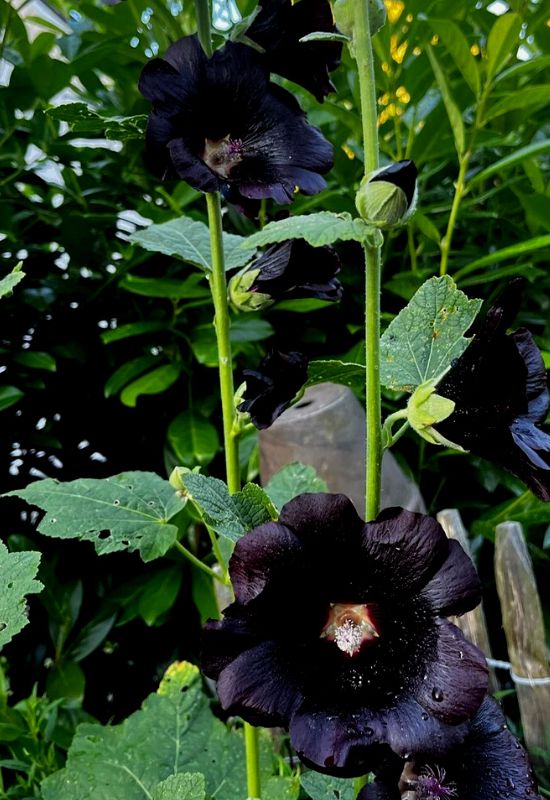
‘Nigra’ is the a hollyhock variety that competes for the podium of the darkest of all, together with ‘Blacknight’. However, I think it has an edge over her rival, because the “blackness” of its deep purple is more stable and more credible, with a deep violet undertone which lacks in her sister.
The glossy quality of the petals makes this shady effect even more visible, and, of course, the center of the bloom has a whitish blotch, on the cream side (though sometimes you may see some pale yellow in it).
The large saucer shaped flowers can reach about 4 inches across (10 cm) and they will start blossoming in mid summer, from the bottom of the spike, and keep going up and up for about two months.
This floral spectacle will attract lots of butterflies and pollinators, and even hummingbirds, all the way to mid season, when it reaches its towering top (up to 8 feet, or 2.4 meters)! The broad and lobed, rough looking leaves that appear under the blossoms spread outward with their decidedly herbaceous look.
Easy to grow and ideal for a vertical accent in borders or even hedges, ‘Nigra’ hollyhock is a biennial or short lived perennial herbaceous plant for informal landscaping styles and naturalized areas, and a must have in any cottage garden. It is also one of the hardiest varieties with black and white blooms.
13: ‘Silver Lace Black’ Polyanthus Primrose (Primuala elatior ‘Silver Lace Black’)
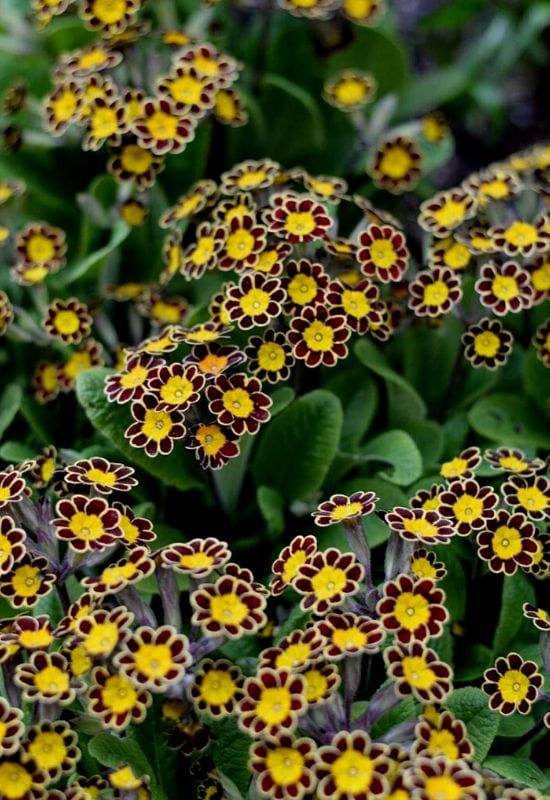
If you don’t mind a third color in the mix, you could grow polyanthus primrose ‘Silver Lace Black’ in your garden. Small and compact, it will brighten up your green haven from low down, near the ground, announcing spring with its lovely round flowers! Coming in small clusters, umbels to be precise, on upright stems, they are quite a show!
Yes, because they have a large golden yellow center, which – true – diverts from our theme, but then you see the many round tipped petals that form a little soft crown around it and…
You will see that they have a very dark purple black color, but the margins are white, hence the name of the series, ‘Silver Laced’…
The blooms are quite showy, despite the size of this perennial, about 1.5 inches across (4.0 cm) and they will last for about two months. Lower down, you will see a lovely rosette of oval leaves, green and lush, but also with a rough and deeply veined surface. And being semi evergreen, you may enjoy them in winter as well!
You can grow ‘Silver Laced Black’ polyanthus primrose under shrubs and trees, as ground cover and even in naturalized areas.
Alternatively, it can find a place in your flower beds, or – why not? – even in containers and window boxes!
14: Dracula Vampira Orchid (Dracula vampira)
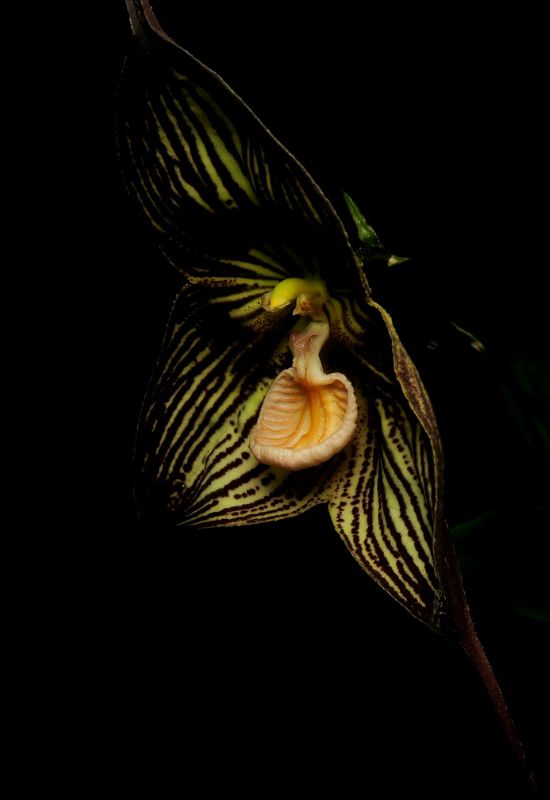
We now meet another orchid with a very gothic look: dracula vampira! As they name suggests, it is a very unusual looking species and it’s hard to describe it… Starting with the size of the flowers…
In fact, most of the blossoms are within 2 to 3 inches across (5.0 to 7.5 cm), but the petals have long tails, like filaments, that make the whole twice as big, 6 inches or 15 cm… The labellum, protrudes like a pouching lip in the middle, giving you the impression of a face looking at you.
Or a mask, maybe, because it has a surreal appearance, and this is also due to the purple black color that is so predominant. However, you will also see stripes of whitish, in the cream range, and these may be yellowish too.
Similarly, you will also see some white in the labellum (mainly at the base), but tonalities of pink and gold or lime green may also appear.
So, while the black is quite steady, the white isn’t. Each blossom will last about 2 weeks, and an inflorescence can last for 2 months. The fleshy and oblong leaves at the base are very glossy, emerald green and exotic looking too.
Unless you have a greenhouse or a conservatory, the best place to grow this quirky looking orchid species is indoors.
On the other hand, it is far easier to find than ‘Stealth’ slipper orchid, at about $25.00 a specimen, and it will give you a very striking centerpiece with black and white blossoms for a room that wants a dramatic twist.
15: ‘Supertunia Latte’ Petunia (Petunia ‘Supertunia Latte’)
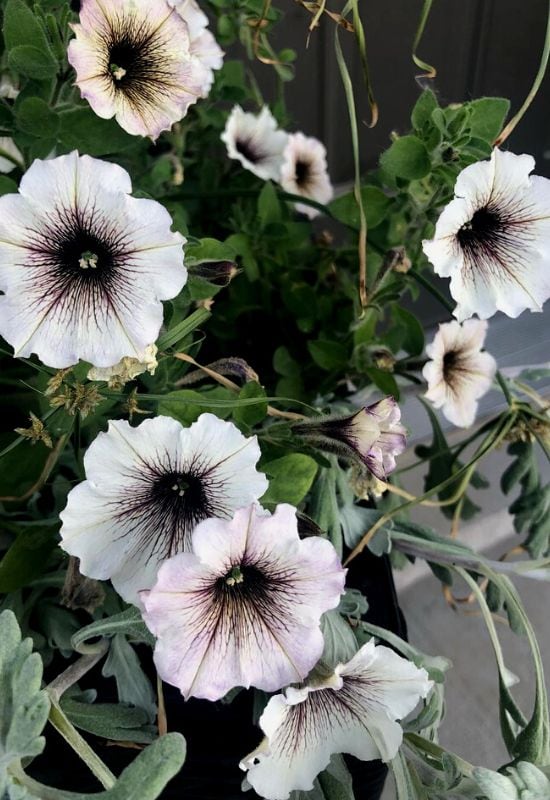
Petunias are a garden favorite because they are marathon bloomers, and they are so easy to grow… And ‘Supertunia Latte’ is the one you are looking for if you like black and white blossoms…
The large flowers will come in huge numbers all through the season on this mounding variety and they are milk colored but with a very dark and convincingly blackish purple center… This extends outwards thanks to an elaborate web of veins, and the overall effect is simply impressive!
A similar variety you may find is ‘Whestoff Crazytunia Black and White’, even difficult to distinguish from our cultivar, but the black may tend to display its plum undertone more easily, and give you a less reliable effect.
Anyway, both will give you the night and day contrast you are looking for in your garden. The leaves – well, you can hardly see them, but as you know, they are fuzzy, herbaceous and green.
Ideal for hanging baskets, ‘Supertunia Latte’ petunia is usually grown as an annual but it is a short lived perennial, not just in containers though… You can easily have it in flower beds and for edging as well.
16: ‘Giant White with Black Face’ Pansy (Viola x wittrockiana ‘Giant White with Black Face’)
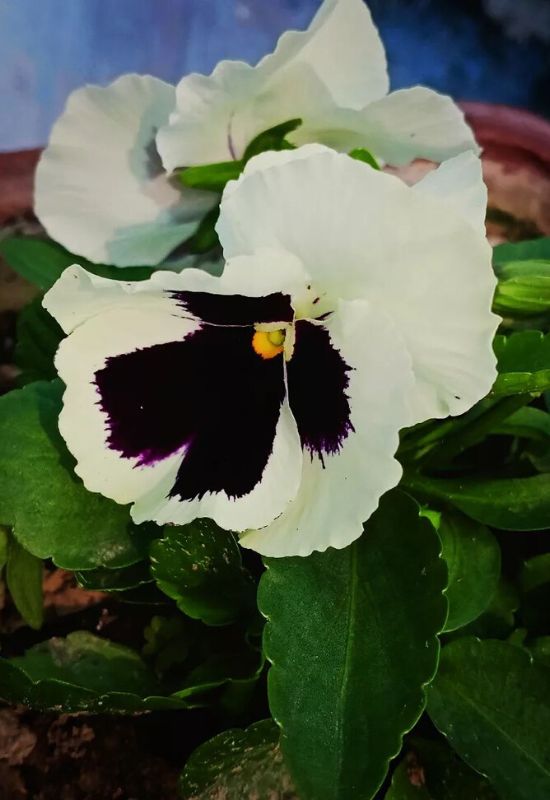
Viola is possibly the genus that competes with orchids for the widest color range, reaching extremely dark tonalities. While fully and convincing black varieties do exist, it is hard to find one that also has white though…
The best is ‘Giant White with Black Face’ pansy, part of a series where the central blotch can be of a range of shades, and the darkest is quite a good result! The blossoms are quite big indeed, thanks to the combination of deep blue and purple that makes up the central blotch on the round petals, apart from the top one, which is fully snow colored.
However, you can still trace the background tonalities if you look at it from a close distance. Generous with its fragrant blossoms, you will see them all the way from spring to fall, each head reaching 2 to 4 inches across (5.0 to 10 cm),
and they sit on a lovely mound of deep green leaves with softly crenated edges. However, this leafy cushion is quite small compared to the size of the blossoms, which clearly take over in the overall effect.
This is not a cold hardy Viola variety, but it looks spectacular! You can grow ‘Giant White with Black Face’ pansy in containers for colder climates, or it can be a protagonist in your flower beds, and even add a black and white effect under shrubs and trees if you underplant them with this zebrine beauty!
17: Flower of an Hour (Hibiscus trionum)
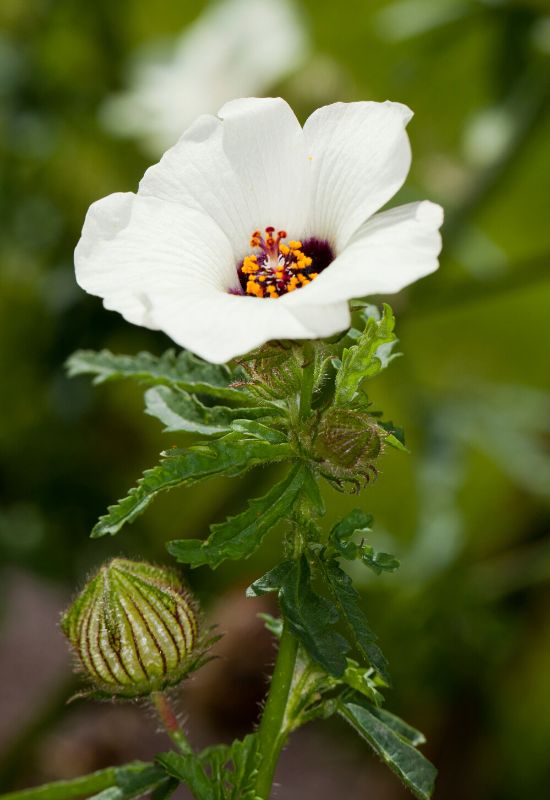
Flower of an hour is a close relative of the famous hibiscus, but quite different in many ways… To start with, it is an annual from the old world and subtropical areas… Next, it does not have the famous long and protruding reproductive tower of the mire famous varieties like rose of Sharon…
Then again, it also gives you the black and white effect you have been looking for. True, there are some shrub varieties with a purple blotch in the center, but in the plant we have picked for you, this is bigger, covering a good part of the base of each petal, and it is quite dark.
True, if you get close, you will notice the tonality is not fully convincing, and you will also notice a golden yellow ring of anthers, but it does work from a distance! The blooms are round and showy, about 2 inches across (5.0 cm), and they come for months on end, from June to October.
They will be followed by seed pods that are really decorative as well, because they look like Chinese lanterns! A clump of deep green, semi glossy and deeply lobed leaves forms a dense mesh that supports this floral display.
Also known as Venice mallow, flower of an hour will give you the contrasting effect of black and white in flower beds or even wild meadows; you can grow it quite easily, and it is suitable for informal garden designs only.
18: ‘Royal Wedding’ Oriental Poppy (Papaver orientale ‘Royal Wedding’)
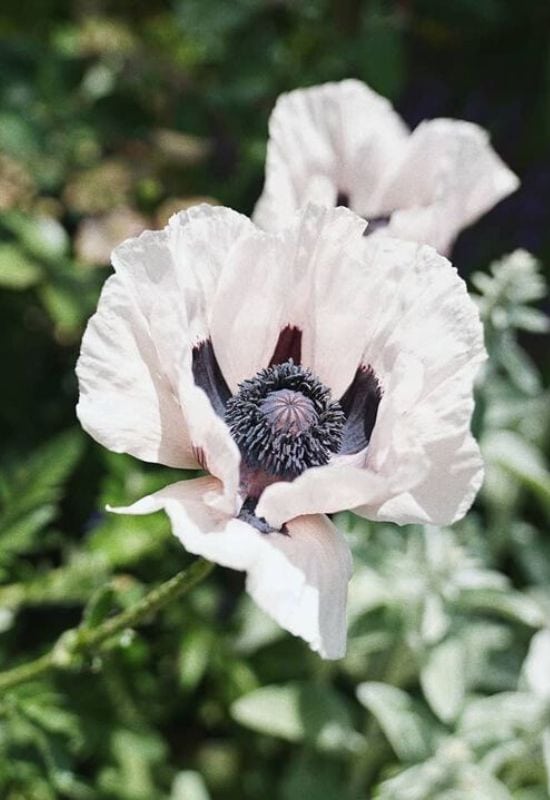
We come to the last plant on our checkered list, and a very convincing variety it is too: ‘Royal Wedding’ oriental poppy! As you know, many members of the Papaver genus have very dark blotches at the cent of the blooms, sometimes looking like charcoal dusting…
And in this cultivar, these are very dark indeed, in fact, you can really call them “black”! Set against the super snow white coloring of the large and paper like petals, the overall effect is extraordinary to say the least. And they are massive! In fact, they can reach an impressive 4 to 6 inches wide when they are fully open (10 to 15 cm)!
Blooming on top of upright stems, frail and delicate looking but showy, these flowers will grace your garden from late spring to early summer, attracting bees, butterflies and other pollinators. The tender looking and bright green leaves at the base are lobed, and they cover the ground with their lush presence.
‘Royal Wedding’ oriental poppy will look great with its black and white blossoms in flower beds or herbaceous in a naturally styled garden, and for a cottage garden, you really can’t do without it…
Black and White Flowers – Not as Rare as You May Think!
As you can see, we have found 18 different varieties with convincing black and white blossoms! They are more than we expected when we set out to find them.
However, remember that black does not really exist in flowers, but they are very sought after. So, if you plant to buy them online, let me give you a final tip: make sure that the pictures have not been photoshopped!

Written By
Margie Fetchik
Margie and Arkansas native has an extensive background in gardening and landscaping. For the last 40 years, Margie has called the Colorado Rocky Mountains her home. Here she and her husband of 36 years raised three kids and owned a successful landscaping company. Margie has a CSU Master Gardener certification. She specialized in garden design & installation, perennial gardens, turf grasses & weeds, flower containers, and the overall maintenance of allHOA, commercial and residential accounts. She and her husband now reside in Denver and are excited about the new experiences’ city life holds.
